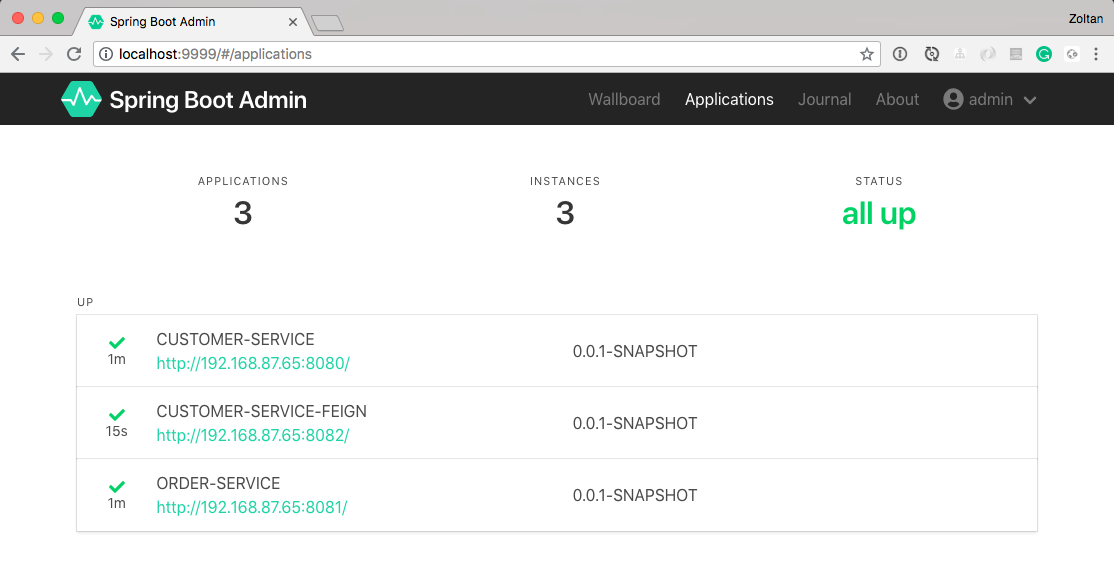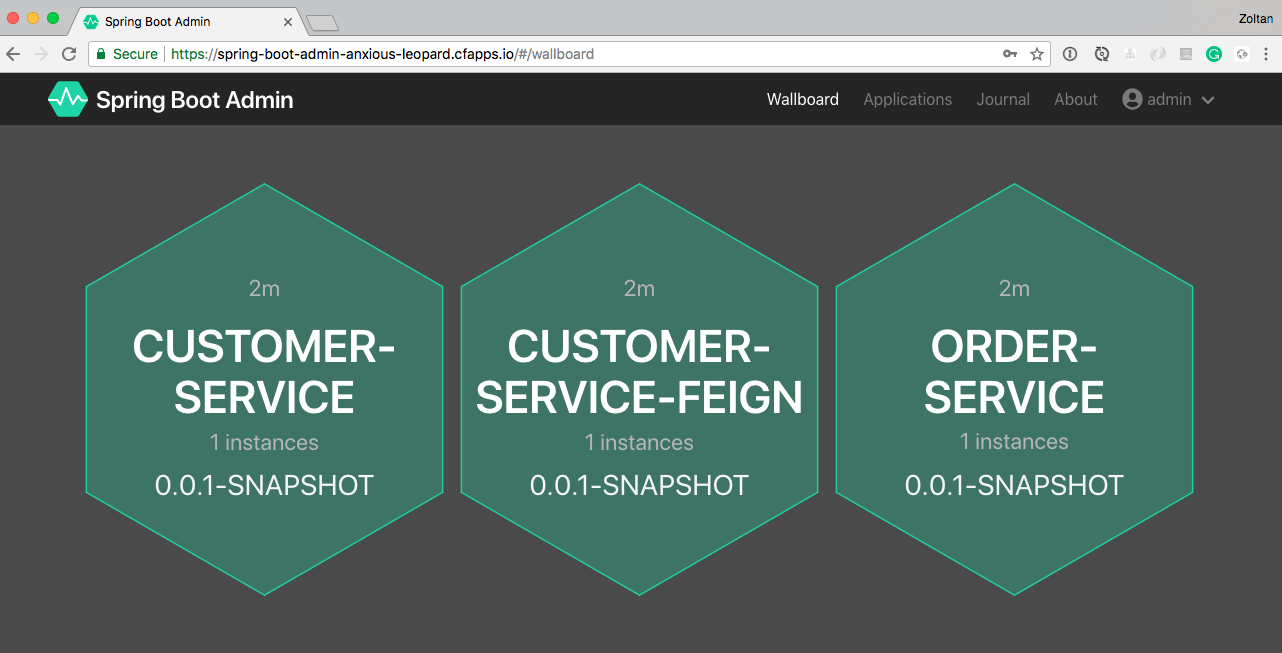Service registry is key component in a microservice architecture which allows applications to dynamically discover and call registered services instead of hand-configuring the used services.
In this blog post we are going to look into Eureka and into Service Registry (which is based on Eureka) from Spring Cloud Services. Eureka comes from Netflix and has two components Eureka Server and Eureka Client.
The Eureka Server can be embedded in a Spring Boot application using the @EnableEurekaServer annotation, but here we look into how to run it using the Spring Boot CLI with Spring Cloud CLI extension installed.
The spring cloud --list lists the available services which can be started
spring cloud --list
configserver dataflow eureka h2 hystrixdashboard kafka stubrunner zipkin
By running
spring cloud eureka
Eureka will be available at http://localhost:8761
We have customser-service and order-service which are two Eureka Clients where the customer-service calls the order-service.
In order that these services register with Eureka Server we need to include the following dependency:
<dependency>
<groupId>org.springframework.cloud</groupId>
<artifactId>spring-cloud-starter-netflix-eureka-client</artifactId>
</dependency>
The customer-service implementation is the following:
@SpringBootApplication
public class CustomerService {
public static void main(String[] args) {
SpringApplication.run(CustomerService.class, args);
}
@Configuration
static class CustomerConfig {
@Bean
@LoadBalanced
public RestTemplate restTemplate() {
return new RestTemplate();
}
}
@RestController
@Slf4j
static class CustomerController {
private static final String TEMPLATE = UriComponentsBuilder.fromUriString("//order-service/orders")
.queryParam("customerId", "{customerId}").build().toUriString();
private final RestTemplate restTemplate;
private final CustomerRepository customerRepository;
public CustomerController(RestTemplate restTemplate, CustomerRepository customerRepository) {
this.restTemplate = restTemplate;
this.customerRepository = customerRepository;
}
@GetMapping("/customers/{id}")
public ResponseEntity<Customer> getCustomer(@PathVariable Long id) {
log.info("getCustomer with id {}", id);
Customer customer = customerRepository.getCustomer(id);
if (customer == null) {
return new ResponseEntity<>(HttpStatus.NOT_FOUND);
}
Order order = restTemplate.getForObject(TEMPLATE, Order.class, id);
if (order != null) {
customer.setOrder(new Order(order.getDetails(), order.getTime()));
}
return new ResponseEntity<>(customer, HttpStatus.OK);
}
}
@Data
@AllArgsConstructor
static class Customer {
Long id;
String name;
Order order;
}
@Data
@NoArgsConstructor
@AllArgsConstructor
static class Order {
String details;
LocalDateTime time;
}
}
We don’t need anymore the @EnableDiscoveryClient annotation, when a DiscoveryClient implementation (like Spring Cloud Netflix Eureka used in this post) is available on the classpath the Spring Boot application registers itself with the service registry. (see more details in EurekaClientAutoConfiguration)
By default the Spring Boot application auto-registers itself. There is a handy /service-registry actuator endpoint in order to query and register/un-register with the service registry
In our example if we want to put the order-service out of service we could use:
echo '{"status":"OUT_OF_SERVICE"}' | http post :8081/actuator/service-registry
After this the customer-service will be able to call the order-service for about 30 seconds, since this is the default for Eureka Clients to look up the registry information to locate their services and make remote calls.
The RestTemplate is no longer created through auto-configuration, in the customer-service we need to create one. We use the @LoadBalanced annotation to make sure it is load balanced across order-service instances.
Using Feign
Another approach for invoking downstream services is to use Feign which gives us a type-safe HTTP client.
@SpringBootApplication
@EnableFeignClients
public class CustomerServiceFeign {
public static void main(String[] args) {
SpringApplication.run(CustomerServiceFeign.class, args);
}
@RestController
@Slf4j
static class CustomerController {
private final OrderServiceClient orderServiceClient;
private final CustomerRepository customerRepository;
public CustomerController(OrderServiceClient orderServiceClient, CustomerRepository customerRepository) {
this.orderServiceClient = orderServiceClient;
this.customerRepository = customerRepository;
}
@GetMapping("/customers/{id}")
public ResponseEntity<Customer> getCustomer(@PathVariable Long id) {
log.info("getCustomer with id {}", id);
Customer customer = customerRepository.getCustomer(id);
if (customer == null) {
return new ResponseEntity<>(HttpStatus.NOT_FOUND);
}
Order order = orderServiceClient.getOrder(id);
if (order != null) {
customer.setOrder(order.getDetails());
}
return new ResponseEntity<>(customer, HttpStatus.OK);
}
}
@FeignClient("order-service")
interface OrderServiceClient {
@GetMapping("/orders")
Order getOrder(@RequestParam("customerId") Long id);
}
}
Using the @FeignClient annotation on an interface the actual implementation is provisioned at runtime. Under the hood a Ribbon load balancer is created.
Spring Boot Admin
Spring Boot Admin is a great tool to manage your Spring Boot microservices. Unfortunately the Spring Boot / Spring Cloud CLI does not have support for it yet, but we can easily setup a Spring Boot Admin Server. After creating a Spring Boot application we need to include the following dependencies:
<dependencies>
<dependency>
<groupId>org.springframework.boot</groupId>
<artifactId>spring-boot-starter-security</artifactId>
</dependency>
<dependency>
<groupId>de.codecentric</groupId>
<artifactId>spring-boot-admin-starter-server</artifactId>
</dependency>
<dependency>
<groupId>org.springframework.cloud</groupId>
<artifactId>spring-cloud-starter-netflix-eureka-client</artifactId>
</dependency>
<dependency>
<groupId>org.springframework.boot</groupId>
<artifactId>spring-boot-starter-web</artifactId>
</dependency>
</dependencies>
and
@SpringBootApplication
@EnableAdminServer
public class SpringBootAdmin {
public static void main(String[] args) {
SpringApplication.run(SpringBootAdmin.class, args);
}
@Configuration
static class WebSecurityConfig extends WebSecurityConfigurerAdapter {
private final String adminContextPath;
public WebSecurityConfig(AdminServerProperties adminServerProperties) {
this.adminContextPath = adminServerProperties.getContextPath();
}
@Override
protected void configure(HttpSecurity http) throws Exception {
SavedRequestAwareAuthenticationSuccessHandler successHandler = new SavedRequestAwareAuthenticationSuccessHandler();
successHandler.setDefaultTargetUrl(adminContextPath + "/");
successHandler.setTargetUrlParameter("redirectTo");
http.authorizeRequests()
.antMatchers(adminContextPath + "/assets/**").permitAll()
.antMatchers(adminContextPath + "/login").permitAll()
.anyRequest().authenticated()
.and()
.formLogin().loginPage(adminContextPath + "/login").successHandler(successHandler).and()
.logout().logoutUrl(adminContextPath + "/logout").and()
.httpBasic().and()
.csrf().disable();
}
}
}

Service Registry on Pivotal Cloud Foundry (PCF)
So far so good. Let’s setup this little example on a Pivotal Web Services (an instance of PCF hosted by Pivotal) where we will use the Service Registry service (trial plan) from Spring Cloud Services
First we need to install the CloudFoundry CLI and create a Pivotal Web Services account.
We create a service instance named service-registry with the following command
cf cs p-service-registry trial service-registry
Then we need to include the following dependencies into the Eureka Client applications (customer-service, customer-service-feign, order-service, spring-boot-admin)
<dependency>
<groupId>io.pivotal.spring.cloud</groupId>
<artifactId>spring-cloud-services-starter-service-registry</artifactId>
</dependency>
It is handy to create manifest.yml file for all services. For customer-service is
applications:
- name: customer-service
memory: 756M
instances: 1
path: target/customer-service.jar
buildpack: java_buildpack
services:
- service-registry
and after building the application with mvn clean package we can deploy with
cf push --random-route
After deploying all the services we should see something like this:
cf apps
name requested state instances memory disk urls
customer-service started 1/1 756M 1G customer-service-shy-mandrill.cfapps.io
customer-service-feign started 1/1 756M 1G customer-service-feign-cheerful-hartebeest.cfapps.io
order-service started 1/1 756M 1G order-service-appreciative-koala.cfapps.io
spring-boot-admin started 1/1 756M 1G spring-boot-admin-anxious-leopard.cfapps.io
and we can test the service:
http customer-service-shy-mandrill.cfapps.io/customers/1
{
"id": 1,
"name": "Paul Molive",
"order": {
"details": "Grilled Chicken Sandwich",
"time": "2018-08-10T07:32:38.463"
}
}
and the Spring Boot Admin console available at:

Good practice to set passwords in environment variables. In the Spring Boot Admin we used the following:
spring:
security:
user:
name: admin
password: ${ADMIN_PASSWORD:admin}
and we set the ADMIN_PASSWORD for the spring-boot-admin application in the development space in Pivotal Cloud Foundry like
cf set-env spring-boot-admin admin s3cr3t
When the customer-service was bound the to service-registry service instance the connection details were set in the VCAP_SERVICES environment variable.
cf env customer-service
{
"VCAP_SERVICES": {
"p-service-registry": [
{
"binding_name": null,
"credentials": {
"access_token_uri": "https://p-spring-cloud-services.uaa.run.pivotal.io/oauth/token",
"client_id": "p-service-registry-f31ae316-8f1c-4a2d-84ab-02062a0c5aae",
"client_secret": "ygjAdaV6Gnff",
"uri": "https://eureka-aa041440-7a75-45b8-bbba-435c79e4ff66.cfapps.io"
},
"instance_name": "service-registry",
"label": "p-service-registry",
"name": "service-registry",
"plan": "trial",
"provider": null,
"syslog_drain_url": null,
"tags": [
"eureka",
"discovery",
"registry",
"spring-cloud"
],
"volume_mounts": []
}
]
}
}
Since we did not configure the the eureka.client.service-url.defaultZone how does it get populated from the VCAP_SERVICES? The magic is included in the EurekaServiceConnector which provides the eureka.client.* properties from the EurekaServiceInfo which encapsulates the information how to access the service-registry service.
All the code examples are on my github